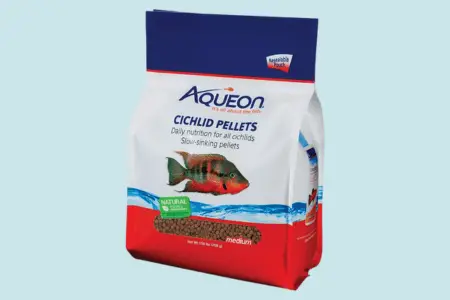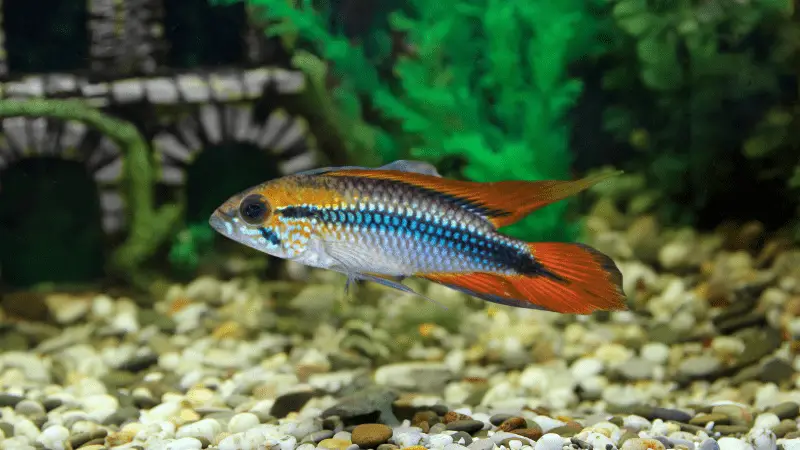Apistogramma agassizii, commonly known as Agassiz’s Dwarf Cichlid, inhabits South American waters. It’s a popular choice for tropical freshwater aquariums due to its vibrant colors and manageable size.
The Apistogramma agassizii, with its dynamic personality and striking appearance, captivates aquarists worldwide. They require moderately soft and acidic water conditions to thrive and display best in a well-planted tank with ample hiding spaces. A well-regarded species among dwarf cichlids, they exhibit complex behaviors and a fascinating breeding process that enthusiasts find rewarding to observe.
Careful attention to their environment and social dynamics ensures a healthy, vibrant community within the aquarium. Ideal for intermediate fishkeepers, the Apistogramma agassizii offers a glimpse into the rich aquatic biodiversity of the Amazon Basin and a splash of color to any dedicated hobbyist’s collection.
Behavior And Care Apistogramma Agassizii
Discovering the unique charm of the Apistogramma Agassizii requires an understanding of their behavior and care. These stunning dwarf cichlids, hailing from the Amazon basin, boast vibrant colors and intriguing personalities. In an aquarium setting, providing the right environment is crucial for their health and happiness. Let’s explore their social behavior as well as the essentials for their tank setup and maintenance.
Social Behavior
The Apistogramma Agassizii, often admired for their serene beauty, display a complex social structure. Being dwarf cichlids, they are generally peaceful but can become territorial during breeding. It’s vital to observe their interactions, especially in mixed-species tanks.
- Males showcase more vibrant colors and establish territories.
- Females tend to be subtler in hue and look after their fry with great care.
- Agassizii thrive in groups, with a ratio favoring more females than males.
Tank Setup And Maintenance
Creating a suitable home for your Apistogramma Agassizii means replicating their natural habitat. They require clean, well-filtered water with plenty of hiding spots.
| Parameter | Requirement |
|---|---|
| Water Temperature | 73-81°F (23-27°C) |
| pH Level | 5.0-7.0 |
| Water Hardness | Soft to Moderate |
Plants and décor provide essential cover. Driftwood and leaf litter offer natural refuge and aid in mimicking their habitat. Regular water changes, typically 25% weekly, keep the environment pristine, preventing stress and disease.
Remember to equip the tank with a gentle filtration system to avoid strong currents. This mimics the slow-flowing streams and backwaters of the Amazon where these fish naturally dwell.
Popular Colors of Apistogramma Agassizii
Some popular color variations of Apistogramma agassizii include:
| Double Red | This variant typically features a vibrant red coloration on the dorsal and caudal fins of the males. The body may have a mix of blue and yellow hues. |
| Triple Red | In this variant, the red coloration extends not only to the dorsal and caudal fins but also to the anal fin. The body coloration can range from blue to yellow. |
| Fire Red | This is another variant with intense red coloration on the fins, and it may also include red markings on the body. |
| Super Red | Similar to the other red variants, the super red Apistogramma agassizii displays a high level of red coloration on the fins and body. |
| Orange Flash | As the name suggests, this variant is characterized by vibrant orange coloration, especially on the fins. |
| Gold | The gold variant features yellow-gold coloration on the body and fins, and it is one of the more subdued but still attractive options. |
| Blue Flame | Some variants may exhibit a bluish coloration on the body and fins, providing a unique and eye-catching appearance. |
Feeding
Apistogramma Agassizii, also known as Agassiz’s Dwarf Cichlid, thrives on a diet that reflects their natural habitat. Proper feeding leads to vibrant colors and healthy fish. This section zeroes in on what to feed these aquatic beauties and how often.
Diet Diversity
A varied diet is key for the Apistogramma Agassizii. In the wild, they munch on a mix of foods. To mimic nature, provide them with:
- Live foods: such as brine shrimp and bloodworms.
- Frozen fare: like daphnia and tubifex worms.
- Flakes and pellets: specifically designed for small cichlids.
Occasional treats of boiled vegetables like zucchini or spinach will enhance their diet.

Feeding Schedule
Apistogramma Agassizii do best with consistent feeding times. Follow this simple plan:
- Twice a day: Feed adult fish in the morning and evening.
- Portion control: Only give as much as they can eat in 3 minutes.
- Fry feeding: Offer smaller, more frequent meals to baby fish.
Stick to the schedule to keep your fish happy and avoid overfeeding.
Breeding Apistogramma Agassizii
Breeding Apistogramma Agassizii can be an exciting adventure for aquatic enthusiasts. With their vibrant colors and dynamic behavior, these dwarf cichlids present a delightful breeding challenge. Understanding their unique needs ensures a successful spawning process. From observing intricate courtship rituals to nurturing the tiny fry, each stage brings its own rewards.

Courtship Behavior
The courtship of Apistogramma Agassizii is a spectacle to behold. Males display striking colors to attract females. They show off their finesse through a dance-like display. Bright fins and swift movements signal a male ready for breeding.
Females inspect potential nest sites, choosing the best for laying eggs. Once a female accepts a male’s advances, spawning occurs in hidden crevices or leaf litter.
Rearing Fry
Rearing Apistogramma Agassizii fry requires care. After hatching, fry feed on their yolk sacs. As they grow, introducing baby brine shrimp or microworms is vital for nutrition.
- Maintain clean water.
- Monitor temperature for ideal fry development.
- Perform regular, small water changes to prevent disease.
With patience and attention, the fry will grow, showcasing the dazzling colors of their lineage.
Health And Diseases
The vibrant Apistogramma Agassizii, a cherished dweller in tropical aquaria, thrives when in good health. Yet, like any living creature, they face health challenges. Understanding common health issues and implementing effective preventive measures is pivotal for their well-being.
Common Health Issues
- Ich or White Spot Disease: Small, white spots on the skin, indicating a parasitic infection.
- Fungal Infections: Cotton-like growths signal fungal presence.
- Bacterial Infections: Red streaks or sores, often stemming from poor water quality.
- Fin and Tail Rot: Frayed or decaying fins or tail, pointing to possible bacterial infection.
Preventive Measures
| Preventive Action | Description |
|---|---|
| Maintain Water Quality | Regular water changes and filter maintenance to keep water parameters stable. |
| Quarantine New Fish | Isolate new arrivals to prevent spread of diseases to existing tank inhabitants. |
| Monitor Fish Behavior | Observe daily for any signs of distress or unusual behavior. |
| Provide Balanced Diet | Feed varied, high-quality food to strengthen their immune system. |
Healthy Apistogramma Agassizii display bright colors and active behavior. A mindful approach to their care ensures these aquatic jewels live a full, vibrant life.
Frequently Asked Questions
What Is The Habitat Of Apistogramma Agassizii?
Apistogramma Agassizii, commonly known as Agassiz’s Dwarf Cichlid, originates from the Amazon basin in South America. They prefer slow-moving, shallow waters with abundant vegetation. Their natural habitat also includes places with leaf litter and driftwood, which provide hiding spots.
How To Care For Apistogramma Agassizii?
To care for Apistogramma Agassizii, maintain a tank with soft, acidic water, a pH of 5. 5-7, and temperatures between 72-86°F. Emulate their natural habitat with plants, caves, and dim lighting. Provide a varied diet of live, frozen, and dried foods for their carnivorous diet.
What Are Apistogramma Agassizii Breeding Habits?
Apistogramma Agassizii are cave spawners, with the female laying eggs inside a sheltered area. Post-spawning, the female guards the eggs while the male protects the territory. Water conditions should be optimal, promoting the hatching of eggs after 2-3 days and fry becoming free-swimming within a week.
Can Apistogramma Agassizii Live With Other Fish?
Yes, Apistogramma Agassizii can coexist with other peaceful and similarly sized fish. Ideal tank mates include tetras, dwarf corydoras, and small plecos. Avoid aggressive or large fish that may bully or eat the dwarf cichlids. Good tank matching prevents stress and potential health issues.
Conclusion
Caring for the Apistogramma Agassizii offers both challenge and reward to the aquarium enthusiast. With their vibrant colors and engaging behaviors, these dwarf cichlids brighten up any tank. By ensuring the right water conditions and diet, you’ll witness the delightful display of their natural habits.
Embrace the journey of nurturing these captivating creatures for a truly enriching aquatic experience.




